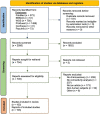Functional Connectivity of the Chemosenses: A Review
- PMID: 35813269
- PMCID: PMC9257046
- DOI: 10.3389/fnsys.2022.865929
Functional Connectivity of the Chemosenses: A Review
Abstract
Functional connectivity approaches have long been used in cognitive neuroscience to establish pathways of communication between and among brain regions. However, the use of these analyses to better understand how the brain processes chemosensory information remains nascent. In this review, we conduct a literature search of all functional connectivity papers of olfaction, gustation, and chemesthesis, with 103 articles discovered in total. These publications largely use approaches of seed-based functional connectivity and psychophysiological interactions, as well as effective connectivity approaches such as Granger Causality, Dynamic Causal Modeling, and Structural Equation Modeling. Regardless of modality, studies largely focus on elucidating neural correlates of stimulus qualities such as identity, pleasantness, and intensity, with task-based paradigms most frequently implemented. We call for further "model free" or data-driven approaches in predictive modeling to craft brain-behavior relationships that are free from a priori hypotheses and not solely based on potentially irreproducible literature. Moreover, we note a relative dearth of resting-state literature, which could be used to better understand chemosensory networks with less influence from motion artifacts induced via gustatory or olfactory paradigms. Finally, we note a lack of genomics data, which could clarify individual and heritable differences in chemosensory perception.
Keywords: chemesthesis; chemical senses; fMRI; functional connectivity; gustation; olfaction; smell; taste.
Copyright © 2022 Farruggia, Pellegrino and Scheinost.
Conflict of interest statement
The authors declare that the research was conducted in the absence of any commercial or financial relationships that could be construed as a potential conflict of interest. The handling editor declared a past collaboration with the authors, MCF.
Figures
Similar articles
-
Investigating effective brain connectivity from fMRI data: past findings and current issues with reference to Granger causality analysis.Brain Connect. 2012;2(5):235-45. doi: 10.1089/brain.2012.0091. Brain Connect. 2012. PMID: 23016794 Free PMC article. Review.
-
Olfactory Loss and Beyond: A Practical Review of Chemosensory Dysfunction.J Am Board Fam Med. 2022 Mar-Apr;35(2):406-419. doi: 10.3122/jabfm.2022.02.210373. J Am Board Fam Med. 2022. PMID: 35379730 Review.
-
Task- and stimulus-related cortical networks in language production: Exploring similarity of MEG- and fMRI-derived functional connectivity.Neuroimage. 2015 Oct 15;120:75-87. doi: 10.1016/j.neuroimage.2015.07.017. Epub 2015 Jul 11. Neuroimage. 2015. PMID: 26169324
-
Olfactory Network Differences in Master Sommeliers: Connectivity Analysis Using Granger Causality and Graph Theoretical Approach.Brain Connect. 2017 Mar;7(2):123-136. doi: 10.1089/brain.2016.0458. Epub 2017 Mar 1. Brain Connect. 2017. PMID: 28125912 Free PMC article.
-
Exploring connectivity with large-scale Granger causality on resting-state functional MRI.J Neurosci Methods. 2017 Aug 1;287:68-79. doi: 10.1016/j.jneumeth.2017.06.007. Epub 2017 Jun 16. J Neurosci Methods. 2017. PMID: 28629720 Free PMC article.
Cited by
-
Future Directions for Chemosensory Connectomes: Best Practices and Specific Challenges.Front Syst Neurosci. 2022 May 30;16:885304. doi: 10.3389/fnsys.2022.885304. eCollection 2022. Front Syst Neurosci. 2022. PMID: 35707745 Free PMC article.
-
Interconnected sub-networks of the macaque monkey gustatory connectome.Front Neurosci. 2023 Feb 16;16:818800. doi: 10.3389/fnins.2022.818800. eCollection 2022. Front Neurosci. 2023. PMID: 36874640 Free PMC article.
-
Odor Pleasantness Modulates Functional Connectivity in the Olfactory Hedonic Processing Network.Brain Sci. 2022 Oct 19;12(10):1408. doi: 10.3390/brainsci12101408. Brain Sci. 2022. PMID: 36291341 Free PMC article.
-
Prediction of alcohol intake patterns with olfactory and gustatory brain connectivity networks.Neuropsychopharmacology. 2025 Jun;50(7):1167-1175. doi: 10.1038/s41386-025-02058-7. Epub 2025 Feb 17. Neuropsychopharmacology. 2025. PMID: 39962224 Free PMC article.
References
-
- Ackerley R., Croy I., Olausson H., Badre G. (2020). Investigating the Putative Impact of Odors Purported to Have Beneficial Effects on Sleep: neural and Perceptual Processes. Chem. Percept. 13 93–105. 10.1007/s12078-019-09269-5 - DOI
-
- Asendorpf J. B., Conner M., de Fruyt F., De Houwer J., Denissen J. J. A., Fiedler K., et al. (2016). ““Recommendations for increasing replicability in psychology.,”,” in Methodological Issues and Strategies in Clinical Research, 4th Edn, ed. Kazdin A. E. (Washington: American Psychological Association; ), 607–622. 10.1037/14805-038 - DOI
Publication types
Grants and funding
LinkOut - more resources
Full Text Sources
Miscellaneous


